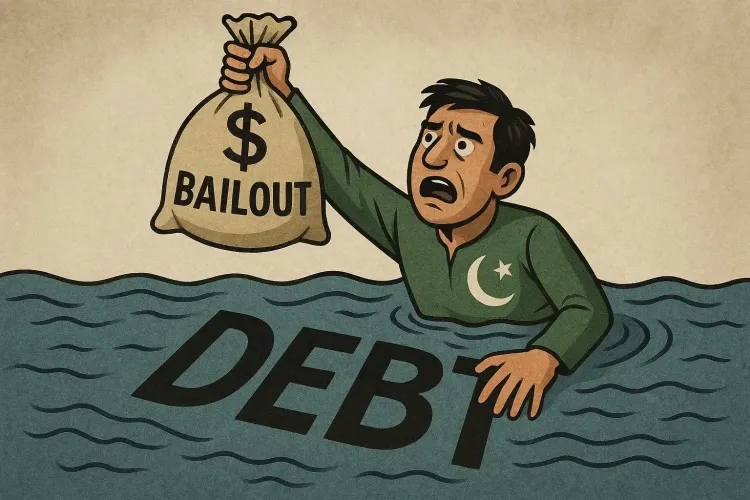Is Pakistan’s Debt Spiral Deepening with Another Bailout on the Horizon?

Synopsis
Key Takeaways
- Pakistan's total external debt has reached approximately USD 135 billion.
- The country owes around USD 30 billion to China, its largest bilateral creditor.
- Pakistan must repay over USD 23 billion in external debts this fiscal year.
- The IMF announced a staff-level agreement for potential support.
- Successful negotiations with the US have led to reduced tariffs on exports.
New Delhi, Oct 15 (NationPress) Amidst a backdrop of various internal challenges, including a Taliban offensive near the Afghan border and the need to maintain a stable relationship with the formidable Pakistan Army, Islamabad finds itself in a dire economic situation, spiraling deeper into debt.
Latest reports indicate that Pakistan’s total external debt has surged to approximately USD 135 billion as of Q2 2025. Notably, the nation owes around USD 30 billion to China, which stands out as one of its most significant bilateral creditors.
This fiscal year, Pakistan is obligated to fulfill over USD 23 billion in external debt repayments, with the central bank estimating total foreign debt obligations and interest at around USD 30.35 billion.
According to the Pakistan Economic Survey 2024-25, the nation's total debt reached Pakistani Rs. 76.01 trillion (approximately USD 267 billion) by the end of March this year, consisting of a domestic debt of Pakistani Rs. 51.52 trillion (around USD 180 billion) and external debt of Pakistani Rs. 24.49 trillion (roughly USD 86 billion).
Public concerns regarding these debts are escalating. Recently, a proactive engagement with Washington appears to have created a conducive environment for unlocking International Monetary Fund (IMF) support.
There has been a notable series of high-level interactions between the US and Pakistani financial officials, aligning with favorable decisions and public indications of backing.
As the principal stakeholder in the IMF, the United States wields significant influence over lending decisions. The recent loan agreement closely followed Pakistan's diplomatic maneuvers in Washington, hinting at a coordinated strategy to secure both political goodwill and financial assistance.
On October 13 and 14, Finance Minister Muhammad Aurangzeb engaged with senior US Treasury officials, investors, and multilateral institutions in Washington, advocating for investment and reform support.
Officials suggest that this ongoing outreach aims to fortify investor confidence, hasten project implementation, and reinforce financial collaborations.
General Asim Munir and Prime Minister Shehbaz Sharif have also been making efforts to strengthen ties with the White House.
On October 14, the IMF disclosed a staff-level agreement regarding reviews under Pakistan's Extended Fund Facility and Resilience and Sustainability Facility, highlighting strong implementation and ongoing commitment from Pakistani authorities.
However, the staff-level agreement (SLA) awaits the IMF Executive Board's approval, as noted by Iva Petrova, who led the IMF team in discussions with Pakistan from September 24 to October 8.
“Following approval, Pakistan will gain access to around US$1.0 billion (SDR 760 million) through the EFF and approximately US$200 million (SDR 154 million) via the RSF, totaling about US$3.3 billion in disbursements,” Petrova remarked.
Special Drawing Rights (SDR) are an international reserve asset established by the IMF, supplementing the currency reserves of member countries and enabling them to exchange it for usable currency when necessary.
Earlier reports suggested that the IMF mission left without finalizing the SLA with Islamabad, as indicated by anonymous sources.
In July, Pakistan and the United States finalized a tariff agreement that reportedly reduced duties on Pakistani exports to 19 percent.
Aurangzeb lauded what his ministry termed as “successful negotiations with the US administration leading to a tariff deal” following discussions in Washington with senior US Treasury officials and investor groups.
Consequently, Pakistan will require the consent of its creditors for rollovers to manage repayments, necessitating a blend of fiscal prudence and additional international financing.









